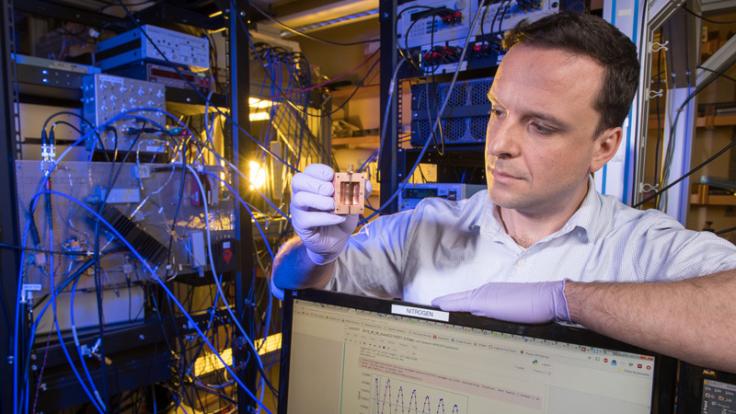Using a particle collider requires a lot of energy.
For one, colliders use superconducting magnets to steer the beams of particles they smash together. The fact that the magnets are superconducting means that once they are powered, they conduct electricity with perfect efficiency—without losing anything to resistance.
But to stay superconducting, these magnets must be cooled to temperatures chillier than outer space. That takes energy.
Refrigeration is also required to keep rooms full of servers from overheating as scientists collect and sort enormous amounts of data, and running those servers takes energy as well.
As scientists discuss the future of particle physics, they are also considering the future of the planet. A white paper produced as part of the Snowmass US high-energy physics community planning process details the ways that building and operating particle accelerators affect the environment—along with ways to mitigate those effects.
“Since we released our white paper on the topic, we’ve been getting quite a lot of interest in this,” says Véronique Boisvert, a professor at Royal Holloway, University of London, one of the authors. “At the Snowmass community meeting [in July 2022], it got quite a lot of acknowledgement, and I think the US community definitely feels that it’s an important topic.”
The paper lays out four areas in which physicists could make a difference: construction, high-power computing, greenhouse gases and travel.
“This has just become, literally, a much hotter topic in the world,” says Ken Bloom, a professor and chair of the physics department at the University of Nebraska, Lincoln, and another author of the white paper. “So to be able to contextualize this for particle physicists has been an interesting opportunity.”
Construction
Constructing a new physics facility, like the proposed Future Circular Collider, is a carbon-intensive process. According to the white paper Boisvert and Bloom worked on, excavation and pouring cement for the main tunnel for the FCC would release 237 kilotons of carbon dioxide, equivalent to the amount released during the redevelopment of a neighborhood in a major city.
Using greener, more sustainable building materials could mitigate some of these effects. For example, green cement, the manufacturing of which does not emit as much carbon as the manufacturing of traditional cement, is becoming a popular alternative.
Changing established processes and using new materials costs money. But Boisvert says she thinks these considerations will become routine for major construction projects in the future.
“These criteria that we’re used to optimizing in terms of the cost, in a sense, need to take into account the context of climate change,” she says. “If we want to minimize emissions, that means using more expensive processes or material, then that goes into the price tag. I think we’ll be forced to do that. I think in 2040, that will just be the kind of world we live in where we’re going to be constantly asked, ‘What are your carbon emissions and how are you minimizing them?’”
Computing
Powering an accelerator is not the only energy expense associated with high-energy physics. Collecting the huge amount of data particle accelerators produce requires high-performance computing.
Data from CERN is transmitted around the world using the Worldwide LHC Computing Grid, which has over 170 computing sites in 42 different countries. The carbon footprint of this activity varies greatly depending on the energy source for the electrical grid in a particular region.
“When we send our computing jobs, we don’t necessarily know exactly where they go because we use farms of computers all over the world,” Boisvert says. “Even two identical, competing jobs might end up using quite different amounts of carbon depending on which computer farm is being used and where it’s located.”
It’s difficult to completely mitigate carbon emissions if a region’s electrical grid runs on fossil fuels. But coordinated efforts to use the smallest amount of energy possible, like performing computing jobs at times of the day when there is less demand on the grid, could help to at least reduce some of these emissions.
European institutions in particular are looking for solutions to this sooner rather than later, Bloom says.
“There’s a lot of concerns about energy supplies,” he says. “The various large computing centers I interact with there, they’re all sort of preparing for possible cutbacks. They might force us to do our computing in a more power-efficient way.”
Greenhouse gases
The gases used in particle physics experiments can also contribute to the overall climate impact of an experiment.
Certain particle detectors use gases like hydrofluorocarbons (HFCs), perfluorocarbons (PFCs) and even sulfur hexafluoride (SF6), which the EPA classifies as the most potent greenhouse gas known. These gases have global warming potentials thousands of times higher than carbon dioxide and trap heat when released into the atmosphere, which contributes to rising global temperatures.
These gases are typically used in particle detectors and cooling systems. They’re good candidates for the job, since they are relatively cheap and their molecules can withstand heat and pressure. However, that tolerance is also what allows them to stick around in the Earth’s atmosphere.
“It’s a challenging problem because the gases really have been optimized for what you want to do, for the quality of the measurements you want to take,” Bloom says. “They’re also optimized for safety, you’ve got to pick nonflammable things that won’t explode.”
In accordance with the Kigali Amendment of the Montreal Protocol, which the US ratified in fall 2022, countries will phase out the use of HFCs by 2047. That will affect future detectors, but it would be difficult to replace the gases currently in use.
“Given where we are on the LHC right now with the experiments we’ve already built, we’re sort of committed to a lot of these gases,” Bloom says. “So you’re down to things like trying to fix leaks in the detectors and trying to do what you can to recuperate and recirculate gas.”
Bloom and Boisvert say now is the time to do R&D to figure out alternatives to these gases for the next generation of detectors.
“We’re used to thinking of a new facility in terms of the physics performance that it needs to achieve, and also in reducing the cost of it to make it easier for funding agencies to approve this project,” Boisvert says. “But I want to add to that list of criteria to take into account the sustainability of it.”
Travel
The white paper also addressed considerations related to travel.
“In some ways, we are in the lead on this, in that we already have these international collaborations that are highly distributed in terms of where the people are,” Bloom says. “We’re good at doing work without having to actually meet up.”
However, scientists still regularly fly to other cities and countries to attend scientific conferences, to spend time required by their collaborations taking shifts collecting data or working on their experiment’s detector, and to meet with other researchers on their experiments.
The rise of virtual events during the pandemic has made it even more possible to attend conferences on the other side of the world without taking a long-haul flight. The white paper suggests continuing to organize virtual and hybrid events. For in-person events, the paper recommends optimizing the location to minimize the distance participants must travel.
The authors propose creating regional hubs for international collaborations, following models such as the LHC Physics Center at Fermilab, a gathering place for US-based scientists working on the CMS experiment at the Large Hadron Collider.
However, implementing changes like these needs to happen in a way that does not isolate scientists from smaller countries or place undue burden on groups historically excluded from science, says Xavier Bertou, a physicist who worked on the regional strategy for high-energy physics, astrophysics and cosmology research in Latin America. A solution that may be convenient for researchers in North America or Europe may not be as convenient for researchers in South America or Africa.
“I am personally a bit worried that these discussions are actually very first-world centered,” Bertou said in an email. “I remember a survey where the first question was, ‘Would you agree to travel by train instead of plane?’ Which just makes no sense for us. There are no trains here, the only options are a 24-hour bus, or a 2-hour plane.”
Boisvert says she wants to find a solution to ensure all can participate fully, no matter where they are in the world. “I think we can’t just go back, we need to sort of keep moving forward,” Boisvert says. “We’ve been at the forefront, so we have to think, ‘Okay, what are the novel, creative ideas to make this happen?’”
All in this together
Climate and environmental impacts are coming up in discussions and planning processes for particle physics around the world.
Along with fellow London-based physicists Chamkaur Ghag, Francesco Spano and David Waters, Boisvert co-authored a white paper on climate impacts for the European Strategy Update. It was signed by almost 300 physicists working in Europe. In September 2022, CERN hosted a workshop about how to make particle physics more sustainable, from using different materials when building new facilities to making changes to the kind of food provided at catered events.
More recently, members of the Energy Working Group for the ongoing African Strategy for Fundamental and Applied Physics have been discussing the environmental impacts of different energy sources.
Discussions about sustainability have also been part of planning the proposed International Linear Collider in Japan. Known as the “Green ILC,” a group of researchers are working on ways to make the facility more environmentally friendly, such as using renewable energy to power the collider and recovering and reusing energy for local communities.
Bloom and Boisvert continue to spread the word about climate change in the context of particle physics. Both have given talks at universities and events, and they created a webpage where members of the particle physics community could register their support for sustainability initiatives in the field.
“Now is the time to start thinking about those criteria to make sure we don’t have to start from scratch,” Boisvert says. “We can put our minds to it. It sends a powerful message to other scientists, it sends a powerful message to government and society that we think, ‘Yes, this is what it means to live in a climate emergency. Whatever you do, you need to take into account the climate change context and what you are doing to minimize it.’”











